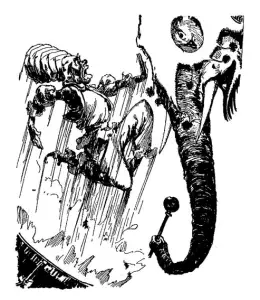While writing my thesis earlier this year, I was so eager to leave grad school behind me, like it was a candy wrapper and I was late to catch a train, that I hardly had time to process the controversial nature of the material I was studying. I wasn’t reading steampunk. Maybe I should have been, but I’ll get to that later. I was compiling an annotated bibliography of publications from New Zealand with content regarding its Jewish citizens. It expected to find offensive material and I was not disappointed.

The first mention of the Jewish settlers I found was from the 1820s and in total I dug up about 200works of literature, histories and academic studies has been published on Jewish settlers in New Zealand. My favorite sources explained how the newly Christianized Maori natives of the island had mistaken themselves for persecuted Jews and the Jewish settlers for some sort of ancient Hebraic deities. Truly the past was a different world. There was even a Jewish New Zealand prime minister who wrote a science fiction novel in 1889, Anno Domini 2000 by Sir Julius Vogel. On a side note, Vogel predicted women would take over the world. True genius.
Nineteenth century early science fiction, like Vogel’s work, is the primordial pulp from which steampunk eventually emerged and it wasn’t a politically correct time. Some of the material I read for my thesis was gruesome. Of course, there were a lot of countless racial slurs and strange misunderstandings, but some of the publications had teeth and justified mistreatment of Jews and/or their extermination while sounding educated and reasonable. It was painful to read.
After I finished my thesis, I thought I could leave this uncomfortable topic behind me. I write fiction as a hobby and started an Oz book immediately after graduation. Bad idea. While doing my research for the Oz story, I unearthed more controversy. As it turns out, in The Silver Princess of Oz written in 1938 by Ruth Plumly Thompson, contained characters that were black-skinned slaves who were never freed. And though the characters Thompson created were actually based on Arabs and Arabic mythology, the illustrator John R. Neill transformed them into brutish thick-lipped caricatures common in literature before World War II. In my story, Bungle of Oz, I freed them.

I submitted the finished work to my proud First Nations friends, being a tribally registered Chippewa myself, and got a response I would have expected had I done my research. “Didn’t you know Frank L. Baum, the original author of the Oz series, called for the extermination of all American Indians?” I hung my head. Reading Nineteenth century and early 20th century literature started to feel like walking over landmines filled with bipolar civil rights activists and belligerent neo-nazis who had failed to take their medication before burying themselves in this otherwise quaint looking field we call literature.
Probably I should drop this topic right now and write a different article, but I can’t. I’m committed and I want to talk about racism in the origins of steampunk, because I think it’s important. Unlike other genres, steampunk grew out of literature unique to this era of social ignorance. Certainly, the same can be said for science fiction, but it’s roots span farther while steampunk is uniquely associated with the late 19th century technology and style and a lot of the influential writing is riddled with racial caricatures common to that period.
Just yesterday I was listening to an audio version of Steampunk by Ann and Jeff VanderMeer when I was faced with an uncomfortable dilemma. Jess Nevins provides an introduction to the popular genre that explains the Victorian worldview and addresses the issues of race relations in steampunk much more deftly than I can. And from his brief history I learned that if the question is whether the origins of Steampunk are rooted in literature with ridiculously racist undertones, his answer, the expert answer, is yes.
Now, I’m faced with the burning internal conflict about how to deal with it? Do I scrap my Oz book and boycott everything associated with the series? Do I throw away my collection of first editions of early Oz works? Being the late bloomer I am, I was just starting to enjoy steampunk. Should I avoid the genre altogether? Only read books published after Obama became president? I came to my eventual conclusion the same way I approach most things. I thought about it over a few cups of coffee. I’m not going to provide examples of what is or isn’t racism in writing. The issue is too subjective. Instead, I’m going have a quick laugh to diffuse the tension and then explain myself.
Recent changes in the publishing industry have allowed a lot of old material to resurface and be searchable from any home with a computer. It’s paved the way for new breeds of hatred to flourish and more people to say dumber things to greater numbers faster than ever. When I stumble across material with racist content, whether or not the author was aware they are offensive, I skip over it. But science fiction entertains me and the clockwork whimsy of steampunk doubly so. And if a genre has influences from a time when something racist was on the tip of almost everyone’s tongue, then that’s how it was and that is in the past. I won’t deny it or bother justifying it.
Good authors can write bad things and bad authors can write good things. If the power goes out in a building and I get stuck in an elevator with a great 19th century novel with a some racist undertones and an awful recently published book without any controversy at all, I’m burning the bad book for warmth and reading the good one. And I can’t apologize enough for that, but I’m still what I’m going to do.
